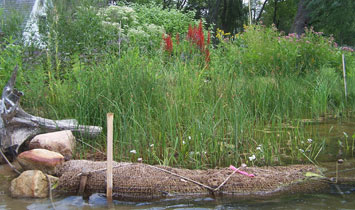Bountiful inland lakes make Michigan a water wonderland, but they need protection
Appreciating Michigan’s inland lakes begins with an understanding of how they were formed and sources of degradation. Upcoming natural shoreline workshop offers ideas for their proper care and long-term management.
 It is easy, especially for Michigan residents, to overlook the countless inland lakes that exist throughout the state. To better appreciate this amazing set of water resources it is helpful to consider how they were formed and how critically important it is to manage them so that future generations can enjoy these resources as well.
It is easy, especially for Michigan residents, to overlook the countless inland lakes that exist throughout the state. To better appreciate this amazing set of water resources it is helpful to consider how they were formed and how critically important it is to manage them so that future generations can enjoy these resources as well.
About 10,000 years ago, Michigan was covered by a one-mile-thick ice sheet. Several advances and retreats of continental glaciers covered Michigan during this time. When the Earth began to warm and the most recent continental glacier retreated from Michigan, it left land strewn with large ice blocks, boulders, rocks and soil particles. Rocks and soil particles washing away from the glacier were deposited upon the land covering the blocks of ice. As the ice blocks melted depressions were left in the land. Some of these depressions were small, some shallow, some large, and some deep. Water from the melting glaciers as well as rain and groundwater filled these depressions to form lakes.
Lakes also are formed by volcanoes, earthquakes, sinkholes and rivers. However, the continental glaciers were by far the primary creators of the world’s lakes, producing 80 percent or more. Since the North American glacier only moved south as far as Indiana, the Upper Midwest and New England are the most lake-rich areas of the United States. In fact, Minnesota, Wisconsin and Michigan have almost 50 percent of the lakes over 100 acres in size found in the continental U.S.
Michigan has 11,000 lakes over five acres in size and thousands more small lakes and ponds. Given the way the glacier created them with differences in size and depth, each lake is uniquely susceptible to sediment and nutrient pollution. Generally the more nutrients, particularly the nutrient phosphorus, that move from the land into the lake the more aquatic plants and algae grow.
Water quality sampling of Michigan’s lakes has found that most lakes are still of reasonably good quality. About 20-30 percent have low phosphorus levels, containing few plants and algae, and are called oligotrophic or “high quality” trout lakes capable of supporting a cold-water fishery. Another 45- 60 percent have moderate phosphorus levels with moderate plants and algae and are called mesotrophic or “good quality” lakes. Lakes with high phosphorus levels and abundant plants are known as eutrophic (15-22 percent). Lakes with extremely high phosphorus levels and excessive plants and algae are called hypereutrophic (4- 5 percent).
Oligotrophic and mesotrophic lakes are very sensitive to phosphorus pollution and can be significantly degraded by even small amounts. Alternatively eutrophic and hypereutrophic lakes are less sensitive to phosphorus pollution. Even major reductions in phosphorus loading to these lakes result in only minor improvements in water quality. Consequently, it’s best to protect lakes while they are still high quality. Once degraded, lakes are very difficult to restore.
One important way to prevent inland lake degradation is to protect shorelines from erosion. This can be accomplished through the use of native plants, biodegradable products and other natural materials. This provides a stable shoreline that is protected from waves and erosion, prevents runoff, provides suitable habitat for fish and wildlife and serves as a natural filter preventing pesticides and fertilizers from directly impacting water quality. This approach to shoreline landscaping is also referred to as bioengineering or softshore engineering.
On Saturday, March 16, 2013, Michigan State University Extension is sponsoring a workshop designed to educate interested lakefront property owners on the importance of natural shoreline landscaping and the use of bioengineering techniques to provide erosion control.
Workshop topics include: Components of a healthy lake ecosystem; designing and maintaining natural landscapes on lake shorelines; using native plants in shoreline landscapes; attracting fish and wildlife to the shoreline; managing shoreline invasive species; and a review of state of Michigan rules and regulations to consider when planning a natural shoreline project.
Several local shoreline projects will be showcased to give participants a better idea of how to deal with their particular shorelines. Numerous educational displays also will be provided by partner organizations to give participants additional shoreline information and resources.
The workshop will be held at MSU Tollgate Education Center in Novi, Mich. Workshop registration is $45 per person on or before March 8, or $55 per person after. Registration includes morning refreshments, lunch, workshop handouts and a copy of MSUE Bulletin E3145, Natural Shoreline Landscapes on Michigan’s Inland Lakes: Guidebook for Property Owners. Visit the event page for complete registration details.
Workshop partners include Michigan Department of Environmental Quality, Oakland County Parks and Recreation, Clinton River Watershed Council, Oakland Conservation District, North Oakland Chapter of Wild Ones, Oakland County Water Resource Commissioner’s office and Cranbrook Institute of Science.
For Michigan’s inland lakes to remain magnificent resources, management efforts are needed to protect them from soil and nutrient pollution. To learn more about lakes and watershed management and view other natural shoreline educational events scheduled around the state, visit: Michigan Natural Shoreline Partnership.



 Print
Print Email
Email


